I'm looking for early (late 16th/early 17th) Irish, English and European wood-and-leather targets, but almost everything I find is late 17th/early 18th c. Scottish. I'm familiar with the Irish target in the Osprey Irish Wars book, but that's the only one I know of (and I read somewhere that's a dodgy ID anyway). I assume construction is pretty consistent in all such shields, but I'd like to know about tacks (brass or steel?) and decorative elements (embossing, tack patterns, boss, etc.). This research is for a target project that won't be, uh, historically rigorous. I'd like to approximate the appropriate weight and look, however. I know how to proceed with the construction, but it's the decorative stuff that's missing. Conventional wisdom seems to be that tack patterns became more complex and dense over time, so I already figured I'd do something simple-concentric circles, say. But would it be reasonable to have only the tacks and no embossing or metal boss?
Hi Sean,
Haven't had a proper look at the Osprey book, but the painting of Sir Neill O'Neill attached to an earlier thread might provide some clues (if this is what you are looking for). While it might be a bit later than what you are looking for, the Irish tended towards conservatism in design. On that basis it wouldn't surprise me if this example was representative of earlier targets.
Looking at the pic in question, it would seem to have a strip of hide securing the rim as one might expect. The tack pattern is relatively simple, but it is impossible to tell if the tacks themselves are brass or steel (unless someone has a coloured version of the painting). There is no boss to speak of and no embossing.
Hope this will be of some use...
David
 Attachment: 8.92 KB
Attachment: 8.92 KB
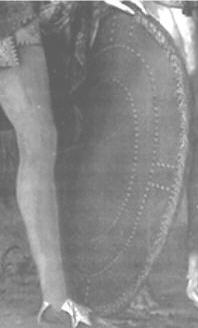
Haven't had a proper look at the Osprey book, but the painting of Sir Neill O'Neill attached to an earlier thread might provide some clues (if this is what you are looking for). While it might be a bit later than what you are looking for, the Irish tended towards conservatism in design. On that basis it wouldn't surprise me if this example was representative of earlier targets.
Looking at the pic in question, it would seem to have a strip of hide securing the rim as one might expect. The tack pattern is relatively simple, but it is impossible to tell if the tacks themselves are brass or steel (unless someone has a coloured version of the painting). There is no boss to speak of and no embossing.
Hope this will be of some use...
David

Sean;
I wonder about how secure a hold the tacks have in the surface material of the shield: If they are prone to popping out too easily it offends my obsession with sturdy construction,; I always prefer stuff that's railroad engineered.
Also tacks on a polearm make me nervous if they should end up in your hand " OUCH " rather than in the shaft where they belong.
Ordinary tacks may have been used but I would be happier with a " tacklike " rivet peened at the back over a washer: The back of the shield covered with felt or something hiding the peening and washers.
A dense pattern of tacks or rivets should increase the cut resistance of the leather covered front of a shield by a considerable degree. And rounded surface should make deflecting a blow easier as the edge of a weapon would tend to skip over the rounded hard tack rather than cut into the surface.
If I was using tacks I would be tempted to put a bit of epoxy cement on the shank and inside surface to maybe help keep them from creaping out a bit a every blow. A bit like the use of lock tight ! Not historical obviously when it comes to epoxy, but could some form of adhesive like tar or pitch have been used?
I wonder about how secure a hold the tacks have in the surface material of the shield: If they are prone to popping out too easily it offends my obsession with sturdy construction,; I always prefer stuff that's railroad engineered.
Also tacks on a polearm make me nervous if they should end up in your hand " OUCH " rather than in the shaft where they belong.
Ordinary tacks may have been used but I would be happier with a " tacklike " rivet peened at the back over a washer: The back of the shield covered with felt or something hiding the peening and washers.
A dense pattern of tacks or rivets should increase the cut resistance of the leather covered front of a shield by a considerable degree. And rounded surface should make deflecting a blow easier as the edge of a weapon would tend to skip over the rounded hard tack rather than cut into the surface.
If I was using tacks I would be tempted to put a bit of epoxy cement on the shank and inside surface to maybe help keep them from creaping out a bit a every blow. A bit like the use of lock tight ! Not historical obviously when it comes to epoxy, but could some form of adhesive like tar or pitch have been used?
Sean;
There just don't seem to be many period representations of such things, are there? Lots of STEEL targets are both illustrated and still around in the Tower Collection and Graz, but not a lot of wooden targets. Yet we of course know that they were used well into the 17th Century by Civilized folks, er rather the English as well as the, er, Scots and Irish using them into the 18th. I know that you are familiar with the quotations that Peterson has in "Arms and Armour in Colonial America" of the fellow with the "pistol proof" wood and leather target. But again, not much more to go on. The McBarron illustration shows pretty much what you are suggesting though, a rather plain, simplified version of what the Highlanders were using 150 years later. I think McBarron probably had good intuition there, and lots of his "guesses" have turned out to be right on the mark.
So I suspect that you would be well served to make up something akin to the later Highland versions, complete with spike if you wish, but with a somewhat simpler design of the tacks. In the meantime, I'll keep my eyes open for period illustrations of such things.
Oh, BTW, if you have access to any used wooden wine barrels, the tops of those are a great starting point for a target! Oak boards fitted together to form a nice round plank, what could be nicer?
Cheers!
Gordon
There just don't seem to be many period representations of such things, are there? Lots of STEEL targets are both illustrated and still around in the Tower Collection and Graz, but not a lot of wooden targets. Yet we of course know that they were used well into the 17th Century by Civilized folks, er rather the English as well as the, er, Scots and Irish using them into the 18th. I know that you are familiar with the quotations that Peterson has in "Arms and Armour in Colonial America" of the fellow with the "pistol proof" wood and leather target. But again, not much more to go on. The McBarron illustration shows pretty much what you are suggesting though, a rather plain, simplified version of what the Highlanders were using 150 years later. I think McBarron probably had good intuition there, and lots of his "guesses" have turned out to be right on the mark.
So I suspect that you would be well served to make up something akin to the later Highland versions, complete with spike if you wish, but with a somewhat simpler design of the tacks. In the meantime, I'll keep my eyes open for period illustrations of such things.
Oh, BTW, if you have access to any used wooden wine barrels, the tops of those are a great starting point for a target! Oak boards fitted together to form a nice round plank, what could be nicer?
Cheers!
Gordon
| Jean Thibodeau wrote: |
| Sean;
I wonder about how secure a hold the tacks have in the surface material of the shield: If they are prone to popping out too easily it offends my obsession with sturdy construction, |
I once made a targe for sparring. I basically used plywood, wrapped it with leather and tacked it with brass furniture tacks. Stood up to a lot of sparring, never had a single tack pop out.
Sean,
I'm glad you asked about this, and I hope someone can come up with something. I asked about this a couple years ago (when making my targe, in fact) on several forums, and I got next to no answers.
Ah! I completely forgot about the O'Neal portrait, and I started that thread! I reckon I'll combine that target and the smaller one from the Osprey book to come up with a speculative piece. Thanks for the additional comments about the hide rim. Do you suppose the front and back covers stop at the edge, leaving bare wood to be covered by the hide? Shouldn't be too difficult to soak and unroll a couple of dog chew toys to get some suitably sturdy rawhide if I decide to go that route. Makes sense, as the hide would provide significant resistance to cuts.
Tacks: I was planning to use furniture tacks. IIRC the nails used in original examples typically were clinched and covered by the backing, so the concern about simple, unclinched tacks is well-justified. However, this target will be for display only, so I'll probably stick with the tacks....so to speak.
Wood: The barrel idea is a good one, but, as the French discovered to their chagrin in the 18th century, Alabama is not the best place for vinoculture (muscadines yes, grapes no). :D Not too many oak barrels lying around down here. Whiskey, maybe....Purists will cringe, I know, but for this first project I've elected to use .75" pine plywood (versus .5" oak plywood or pine/oak plank construction). If this piece turns out well I may try authentic construction techniques later on. By the way, Gordon, you'll appreciate that I've also considered getting one of MRL's steel renaissance targets and painting it white, with a red cross of St. George, to match the targets carried by border cavalry in the Irish wars.
All good comments, folks. Thanks for the help!
Tacks: I was planning to use furniture tacks. IIRC the nails used in original examples typically were clinched and covered by the backing, so the concern about simple, unclinched tacks is well-justified. However, this target will be for display only, so I'll probably stick with the tacks....so to speak.
Wood: The barrel idea is a good one, but, as the French discovered to their chagrin in the 18th century, Alabama is not the best place for vinoculture (muscadines yes, grapes no). :D Not too many oak barrels lying around down here. Whiskey, maybe....Purists will cringe, I know, but for this first project I've elected to use .75" pine plywood (versus .5" oak plywood or pine/oak plank construction). If this piece turns out well I may try authentic construction techniques later on. By the way, Gordon, you'll appreciate that I've also considered getting one of MRL's steel renaissance targets and painting it white, with a red cross of St. George, to match the targets carried by border cavalry in the Irish wars.
All good comments, folks. Thanks for the help!
Sean;
Well, I was GOING to mention the white-painted steel targets of the Borderers, with the red Cross of St. George on them, but thought better of it! :D I'm actually still working on one of those myself. I got a large spun steel disc with a heavy solid round rim welded to it. Now to figure out just where I want to drill the holes for the straps, and just what to line it with!
I did pick up a nice slightly smaller steel target from Steve Moffatt (he made a couple of the Katzbalgers in Nathan's collection, and does a great job of armouring) It's made of three pieces of steel rivetted together with a central boss, and a stout wood liner as well. The back is covered with heavy leather too. Heavy, it is! I'll see if I can take some pics of it today to post for you.
BTW, I noticed that ALL of the English steel targets I've seen illustrated ("Image of Ireland" and the Lant Roll of Sir Philip Sydney's funeral procession) show, or imply, guige straps, so I would suggest one for your wooden target as well. Besides, you need something to hang it from the wall with!
Cheers!
Gordon
Well, I was GOING to mention the white-painted steel targets of the Borderers, with the red Cross of St. George on them, but thought better of it! :D I'm actually still working on one of those myself. I got a large spun steel disc with a heavy solid round rim welded to it. Now to figure out just where I want to drill the holes for the straps, and just what to line it with!
I did pick up a nice slightly smaller steel target from Steve Moffatt (he made a couple of the Katzbalgers in Nathan's collection, and does a great job of armouring) It's made of three pieces of steel rivetted together with a central boss, and a stout wood liner as well. The back is covered with heavy leather too. Heavy, it is! I'll see if I can take some pics of it today to post for you.
BTW, I noticed that ALL of the English steel targets I've seen illustrated ("Image of Ireland" and the Lant Roll of Sir Philip Sydney's funeral procession) show, or imply, guige straps, so I would suggest one for your wooden target as well. Besides, you need something to hang it from the wall with!
Cheers!
Gordon
Yeah, I'll almost certainly add a guige strap.
By the way, do you have the book The Renaissance at War? In the same painting that gave me my boar spear model (just a couple of steps ahead of that officer, in fact) are two boys bearing targets (barely bearing them, by the looks of it). One of them is turned so that the back of one target is visible. If you haven't seen that detail, it might be worth a look. It's the march of the Catholic League through Paris, 1588.
Thanks for the full-color O'Neill, Mac! That makes the edging of the target look less like rawhide and more like decoration on top of the leather cover, which does seem to wrap over the edge.
By the way, do you have the book The Renaissance at War? In the same painting that gave me my boar spear model (just a couple of steps ahead of that officer, in fact) are two boys bearing targets (barely bearing them, by the looks of it). One of them is turned so that the back of one target is visible. If you haven't seen that detail, it might be worth a look. It's the march of the Catholic League through Paris, 1588.
Thanks for the full-color O'Neill, Mac! That makes the edging of the target look less like rawhide and more like decoration on top of the leather cover, which does seem to wrap over the edge.
Sean;
I am familiar with that painting, and I'll have to check out the pages carrying the targets. Interesting use for small boys, carrying shields, I must say... gives them some useful employment! Since it is right in the period in which I am most interested, it ought to be just what I'm looking for. Thanks for the suggestion!
On the O'Neill painting, is that fringe on the outside of the target, around the edge? I'm familiar with it being inside on the edge of steel targets, but this is interesting and different.
Cheers!
Gordon
I am familiar with that painting, and I'll have to check out the pages carrying the targets. Interesting use for small boys, carrying shields, I must say... gives them some useful employment! Since it is right in the period in which I am most interested, it ought to be just what I'm looking for. Thanks for the suggestion!
On the O'Neill painting, is that fringe on the outside of the target, around the edge? I'm familiar with it being inside on the edge of steel targets, but this is interesting and different.
Cheers!
Gordon
| Gordon Frye wrote: |
| On the O'Neill painting, is that fringe on the outside of the target, around the edge? I'm familiar with it being inside on the edge of steel targets, but this is interesting and different. Cheers! Gordon |
Here's a blowup of the target .... but the image quality is poor ! Mac
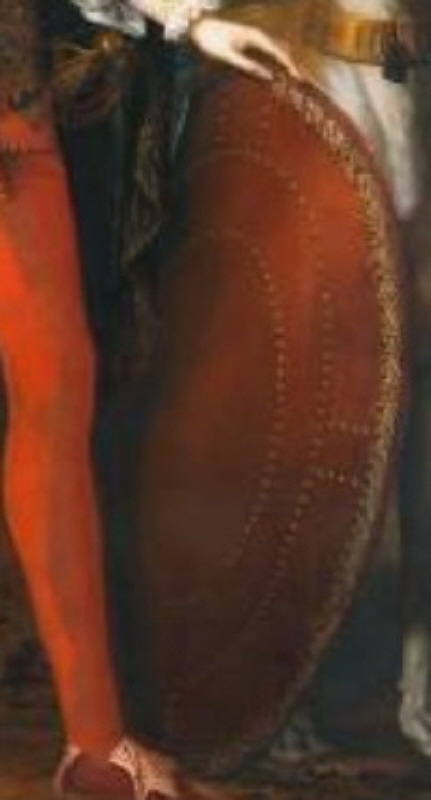
Now that you mention it, Gordon, I think that might be fringe. The Renaissance at War painting shows a number of other targets, some with the kind of fringe you're talking about. Looks to be a relatively stiff fringe attached to the inside of the rim. Maybe the same stuff they used for polearm tassles? The stuff I use for my polearm tassles comes by the yard, and would be easy to tack to the surface of a target. It comes in a variety of colors, including gold. Hmmm. I just wonder if that's what we're seeing in this image....
I'm seeing some kind of pattern in that decoration. Something like this:
–––
• • •
–––
X
–––
• • •
–––
X
–––
• • •
–––
X
–––
–––
• • •
–––
X
–––
• • •
–––
X
–––
• • •
–––
X
–––
Sean;
Here are a couple of pics of my steel target by Steve Moffatt of San Jose, CA. As noted above, made from three pieces, and all riveted together, with a wooden backing covered in leather. The straps are held on by the through-rivets and burrs. I still need to afix a guige to it though!
Cheers,
Gordon
 Attachment: 38.23 KB
Attachment: 38.23 KB
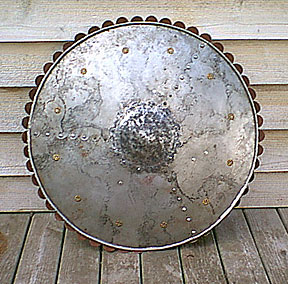
Moffatt Target, obverse
 Attachment: 28.07 KB
Attachment: 28.07 KB
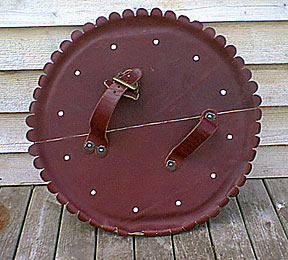
Reverse side
 Attachment: 30.12 KB
Attachment: 30.12 KB
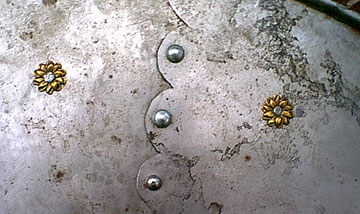
Close-up of overlap
Here are a couple of pics of my steel target by Steve Moffatt of San Jose, CA. As noted above, made from three pieces, and all riveted together, with a wooden backing covered in leather. The straps are held on by the through-rivets and burrs. I still need to afix a guige to it though!
Cheers,
Gordon

Moffatt Target, obverse

Reverse side

Close-up of overlap
Oooh, very pretty! Love the brass rosettes. I'm gonna have to get crackin' on my project! I need to finish painting a scutum for my wife, then on to the target!
Gordon;
That steel target is great looking: Is the surface activity artificial aging or forge marks ? Maybe deliberate etching of the surface ? Whatever it is I could spend a long time just looking at it caressing it with my eyes. :cool:
So how many other neat toys have you kept secret. :p :lol:
That steel target is great looking: Is the surface activity artificial aging or forge marks ? Maybe deliberate etching of the surface ? Whatever it is I could spend a long time just looking at it caressing it with my eyes. :cool:
So how many other neat toys have you kept secret. :p :lol:
Thanks for the complements, guys! I just picked that up a couple of months or so ago, actually, and really haven't had much of a chance to do much with it. I too rather like the brass rosettes, they're very much like the one's seen on the Graz targets. But that little sucker is HEAVY! Lots heavier than a plain wooden shield of the same size, obvilously (I think Steven may well have used one of the oak barrel ends I gave him a few months ago to "line" it with! It's about the right size and all...) But on the other hand, a thicker steel target is heavier, so I should be happy! I still haven't taken it out into the pasture to "proof" it yet, heck, maybe I'll do that this weekend... :D
I'm not sure as to the origin of the surface "etching" though. Looks to be that it's from some long-lost rust or something, but perhaps it's from some hot work, since I do believe Steven did a some on it, though I couldn't state that as an absolute. In any event, it DOES look pretty cool, I must say! Definitely makes it look like it's seen service, that's for sure.
All in all, I like the look and feel of it, and when it came up for sale from a third party, you can bet that I jumped on it "Like a hen on a June-bug" as they say in Texas! :D So I'm quite happy with my acquisition!
Okay, Sean, now you HAVE to complete that scutum for the Wife and get cracking on your target!
Cheers!
Gordon
I'm not sure as to the origin of the surface "etching" though. Looks to be that it's from some long-lost rust or something, but perhaps it's from some hot work, since I do believe Steven did a some on it, though I couldn't state that as an absolute. In any event, it DOES look pretty cool, I must say! Definitely makes it look like it's seen service, that's for sure.
All in all, I like the look and feel of it, and when it came up for sale from a third party, you can bet that I jumped on it "Like a hen on a June-bug" as they say in Texas! :D So I'm quite happy with my acquisition!
Okay, Sean, now you HAVE to complete that scutum for the Wife and get cracking on your target!
Cheers!
Gordon
Gordon;
Lets just hope that the proof load creates a nice dimple and not a " depressing " through and through hole. :eek:
Now, I may have made you nervous about the whole thing :( :p :lol:
Go for a load giving you the equivalent to a hit at at least 25 to 50 yards or an accidental musket ball hit by a long range and spent shot ! Not a point blank " Elephant killer load ".
Think .38 call S & W not .50 Desert Eagle. ( Modern load equivalent ! I assume you will use one of your Snaphaunce pistols ).
Jokes aside, I'm sending all my support for good luck to the shield. :\
Lets just hope that the proof load creates a nice dimple and not a " depressing " through and through hole. :eek:
Now, I may have made you nervous about the whole thing :( :p :lol:
Go for a load giving you the equivalent to a hit at at least 25 to 50 yards or an accidental musket ball hit by a long range and spent shot ! Not a point blank " Elephant killer load ".
Think .38 call S & W not .50 Desert Eagle. ( Modern load equivalent ! I assume you will use one of your Snaphaunce pistols ).
Jokes aside, I'm sending all my support for good luck to the shield. :\
Shields which looked very similar to Scots targets were used in Georgia and the Caucasus until the early 20th century.
Check put the last picture in post number 3 here:
http://www.vikingsword.com/vb/showthread.php?...ht=georgia
And this website, these are all replicas though.
http://www.gotscha.nl/uk-abjari.htm
http://www.gotscha.nl/uk-phranguli.htm
Check put the last picture in post number 3 here:
http://www.vikingsword.com/vb/showthread.php?...ht=georgia
And this website, these are all replicas though.
http://www.gotscha.nl/uk-abjari.htm
http://www.gotscha.nl/uk-phranguli.htm
Page 1 of 1
You cannot post new topics in this forumYou cannot reply to topics in this forum
You cannot edit your posts in this forum
You cannot delete your posts in this forum
You cannot vote in polls in this forum
You cannot attach files in this forum
You can download files in this forum
All contents © Copyright 2003-2006 myArmoury.com — All rights reserved
Discussion forums powered by phpBB © The phpBB Group
Switch to the Full-featured Version of the forum
Discussion forums powered by phpBB © The phpBB Group
Switch to the Full-featured Version of the forum
